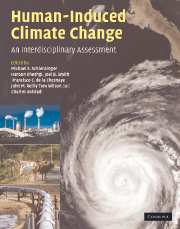Book contents
- Frontmatter
- Contents
- List of contributors
- Preface
- Part I Climate system science
- Part II Impacts and adaptation
- Part III Mitigation of greenhouse gases
- 15 Bottom-up modeling of energy and greenhouse gas emissions: approaches, results, and challenges to inclusion of end-use technologies
- 16 Technology in an integrated assessment model: the potential regional deployment of carbon capture and storage in the context of global CO2 stabilization
- 17 Hydrogen for light-duty vehicles: opportunities and barriers in the United States
- 18 The role of expectations in modeling costs of climate change policies
- 19 A sensitivity analysis of forest carbon sequestration
- 20 Insights from EMF-associated agricultural and forestry greenhouse gas mitigation studies
- 21 Global agricultural land-use data for integrated assessment modeling
- 22 Past, present, and future of non-CO2 gas mitigation analysis
- 23 How (and why) do climate policy costs differ among countries?
- 24 Lessons for mitigation from the foundations of monetary policy in the United States
- Part IV Policy design and decisionmaking under uncertainty
- Index
- Plate section
- References
16 - Technology in an integrated assessment model: the potential regional deployment of carbon capture and storage in the context of global CO2 stabilization
from Part III - Mitigation of greenhouse gases
Published online by Cambridge University Press: 06 December 2010
- Frontmatter
- Contents
- List of contributors
- Preface
- Part I Climate system science
- Part II Impacts and adaptation
- Part III Mitigation of greenhouse gases
- 15 Bottom-up modeling of energy and greenhouse gas emissions: approaches, results, and challenges to inclusion of end-use technologies
- 16 Technology in an integrated assessment model: the potential regional deployment of carbon capture and storage in the context of global CO2 stabilization
- 17 Hydrogen for light-duty vehicles: opportunities and barriers in the United States
- 18 The role of expectations in modeling costs of climate change policies
- 19 A sensitivity analysis of forest carbon sequestration
- 20 Insights from EMF-associated agricultural and forestry greenhouse gas mitigation studies
- 21 Global agricultural land-use data for integrated assessment modeling
- 22 Past, present, and future of non-CO2 gas mitigation analysis
- 23 How (and why) do climate policy costs differ among countries?
- 24 Lessons for mitigation from the foundations of monetary policy in the United States
- Part IV Policy design and decisionmaking under uncertainty
- Index
- Plate section
- References
Summary
Introduction
Stabilizing the concentration of greenhouse gases implies stabilizing the concentration of carbon dioxide (CO2), the most important greenhouse gas. As Wigley et al. (1996) showed, this goal implies a peak in emissions of carbon to the atmosphere followed by a decline in global carbon emissions that goes on indefinitely thereafter. Carbon dioxide from fossil fuel burning is the dominant anthropogenic emission to the atmosphere. A central question in limiting emissions is therefore how to provide the energy services that are at present delivered predominantly using fossil fuels, without concurrently releasing CO2 into the atmosphere. Prior analysis, including that of Edmonds et al. (2004), has shown that carbon dioxide capture and storage (CCS) has the potential to reduce emissions and limit emissions mitigation costs. Furthermore, earlier surveys of aggregate global CO2 storage capacity such as Edmonds et al. (2001) indicate that potential gross global reservoir capacity is larger – potentially many times larger – than the scale of gross global CO2 capture from energy and industrial processes over the course of the twenty-first century. However, this simplification does not reflect the reality that CO2 would be captured at point sources and deposited into specific reservoirs. Work has begun to consider local source–reservoir relationships within a specific country (see for example Dooley et al. [2004]). The analysis we present here is the first to examine the implications of regionally heterogeneous CO2 storage on a global scale.
- Type
- Chapter
- Information
- Human-Induced Climate ChangeAn Interdisciplinary Assessment, pp. 181 - 197Publisher: Cambridge University PressPrint publication year: 2007
References
- 5
- Cited by



